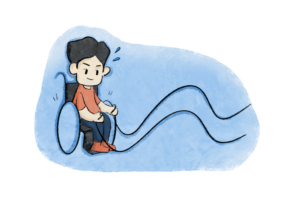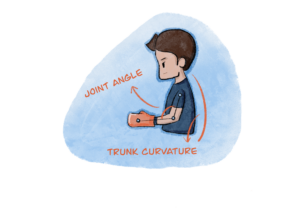 | 1 comment
| 1 comment
Lay summary by Xueqing Zhou
Edited by Jocelyn Chan
This is the lay summary written on the paper “Trunk muscle activity and kinematics during boxing and battle rope exercise in people with motor-complete spinal cord injury” by Gevorg Eginyan, Alison Williams, Konrad Joseph and Dr. Tania Lam. Read the original article here.
The goal of this study was to describe the upper-body movement patterns during seated boxing and battling rope exercises in individuals with motor-complete spinal cord injury (SCI). Specifically, the researchers looked at trunk muscle activation patterns and upper-body kinematics (motion analysis without considering force). Trunk muscles can generally be thought of as upper-body muscles since the trunk refers to the torso, which contains the chest, abdomen, pelvis and back. Therefore, trunk muscles are very important for both breathing and movement.
How was the study done?
4 people with motor-complete SCI and 4 uninjured controls participated in this study, and performed 3 boxing exercises followed by 2 battle rope exercises. The researchers used electromyography (EMG) to quantify the electrical activity of the muscles in the abdomen and along the spine. In addition, a motion capture system was used to measure joint angles and the degree of trunk curvature during the exercises.


Limitations of this included its very small sample size. Although the movement patterns found in this study were fairly consistent, further research with a larger and more diverse sample is needed. Also, the participants in this study were new to boxing-based exercises; this is a possible limitation because training status and familiarity with the exercises might affect EMG and kinematic results.
What were the results of this study?
The main findings of this study were that:
 Seated boxing and battle rope exercises are able to activate trunk muscles, more so in people with motor-complete SCI (evidenced by higher EMG values) than in uninjured controls.
Seated boxing and battle rope exercises are able to activate trunk muscles, more so in people with motor-complete SCI (evidenced by higher EMG values) than in uninjured controls.- People with motor-incomplete SCI had generally similar upper-body kinematics compared to controls, but showed reduced trunk rotation and increased trunk curvature.
- The increased trunk curvature might be a strategy for people with motor-complete SCI to maintain seated balance during these exercises.
What does this mean for the SCI community?
The trunk muscles are very important for supporting seated balance. People with motor-complete SCI are more likely to have weakened seated balance because trunk muscle function is more severely impaired after injury. One unique feature of the trunk muscles (compared to the arm/leg muscles) is that people with high-thoracic or cervical motor-complete SCI may retain some voluntary control over these muscles below the level of injury, despite their clinical diagnoses. This broadens the rehabilitation opportunities for people with motor-complete SCI.
Activation of the trunk muscles during boxing-based exercises supports the development of such exercise interventions to train and improve seated balance for people with motor-complete SCI.

